ASUS X72D/K72DR: Three Cores, No Waiting
by Dustin Sklavos on October 25, 2010 12:01 AM ESTScreen Analysis—Not Bad
If the ASUS X72D has a strong point, it has to be the screen. While it's still a TN panel with a mediocre gamut, this isn't a clear loss and it's an improvement over the screens we're used to seeing. Some might take issue with the relatively low 1600x900 resolution, but at least this resolution offers enough vertical space to be useful (as opposed to the utterly poor 1366x768 so common on smaller notebooks.)
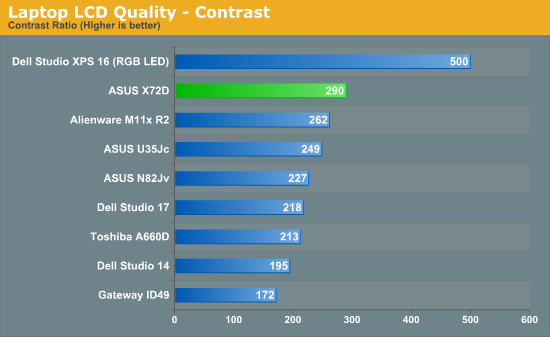

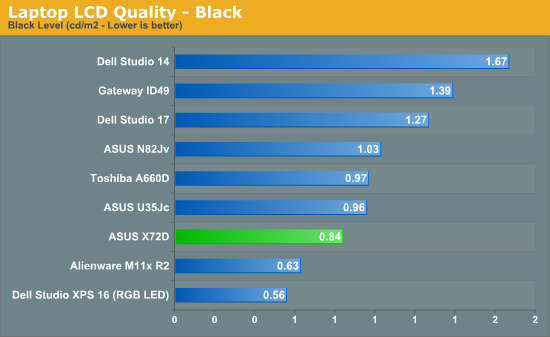
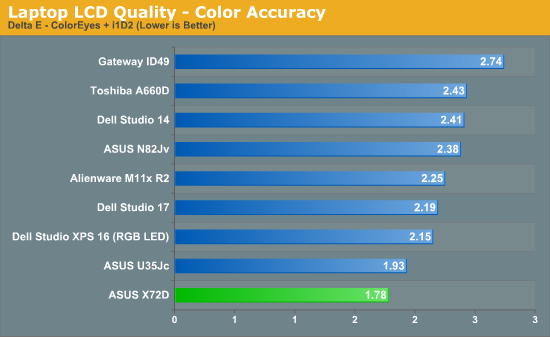

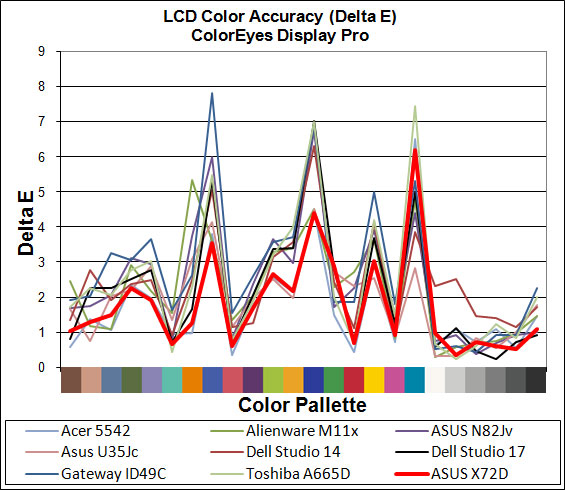
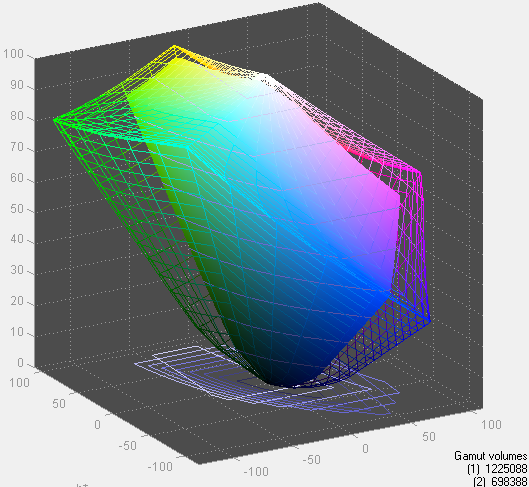
It's not consistently placing at the top or bottom of our charts, but the results for the X72D's screen need to be taken in perspective: brightness is still perfectly acceptable, contrast is in line with the better screens we've seen on entry notebooks, and overall color accuracy and gamut is actually pretty decent for a TN panel. Is this screen going to win any awards? No, but it's still notably better than most of the mediocre TN panels that come through here.
Viewing angles aren't bad either, and it's not as hard to find the sweet spot on the X72D as it is on the Dell Studio 17. While we'd still like to see high quality 1080p panels in notebooks, the screen on the X72D at least feels like a step in the right direction, and ASUS does this without breaking the bank.
















37 Comments
View All Comments
debacol - Tuesday, October 26, 2010 - link
Except it isn't useful. The i3 compares to it in performance yet destroys it in battery life. Plus you can get a similar laptop with an i3 in it for cheaper than this. I'm really hoping bobcat competes, because Intel has completely mopped the floor with AMD in the mobile sector.Malih - Tuesday, October 26, 2010 - link
+1this cries for Zacate, I'm on the market for 12"/13" new notebook right now, but until Zacate is released and reviewed here on AT i'm not gonna make any decision, my 3 years old 12" acer 2920z will still be around.
xxtypersxx - Monday, October 25, 2010 - link
Holy thermals, that is high for even an intel chip and all the guidance I have ever seen with AMD's 45nm chips reccomends 60-70C as the top end.blackshard - Tuesday, October 26, 2010 - link
60-70°C are reccomendations for desktop chips.mobile chips have far higher tolerances (up to 100°C and more).
mino - Monday, October 25, 2010 - link
Reasons for 5470 to exist:1) Crappy/incompatible Intel IGP drivers (counts for Intel platform)
2) 3x the performance of IGP's (RS880/Arrandale)
3) Hybrid Crossfire anyone ??? You mention the uselessness of IGP and yet you not even bother mentioning whether Hybrid crossfire id available ...
Sorry Dustin, but your bashing of HD5470 is just a spoiled kid's talk not worth of this site.
This issue aside, thanks for an interesting revue.
JarredWalton - Monday, October 25, 2010 - link
Take your comments in light of the laptop being reviewed and you'll see the problem. Intel IGP is a different platform, 3x slow is still slow, and ASUS didn't use Hybrid CrossFire--or switchable graphics. The bigger problem is that there's just not much utility in these low-end parts anymore.If you were talking about the old Core 2 GMA 4500MHD IGP, I'd give you point one, but the Intel HD Graphics has had very few problems, particularly with the latest drivers. It is, as far as I'm concerned, essentially equal to the HD 4200 IGP. Yes, there are a few areas where I'd give the 4200 the edge, but for casual users it just doesn't matter. It can handle HD video (including YouTube HD), and even if you wanted to argue about audio bitstreaming capabilities Intel can do DTS-HD and DD TrueHD if I'm not mistaken (though it may require getting a setup with proper BIOS support).
Anyway, I'll give you the existence of the HD 5470 as something the market wants, but when we say "the market" I think we all understand that it really means "big OEMs like Dell and HP". Any consumer that knows their stuff understands that entry-level discrete graphics chips are a joke. The "midrange" stuff only costs a bit more, typically doubles performance and allows improved quality, and it doesn't even use that much more power. If you have switchable graphics thrown in, then there's really no reason to bother with 5470.
NVIDIA's GT 415M looks to be more like a low-end 5650 competitor based on the specs, so hopefully the next-gen AMD mobile parts will finally move beyond the pathetic 80 Stream Processor mark. That's our real complaint: IGP = 40 SP, entry dGPU = 80 SP, midrange GPU = 400 SP. That's a major jump in shader capabilities.
Dustin Sklavos - Monday, October 25, 2010 - link
Jarred covered me but I'd like to point out...we haven't had Hybrid Crossfire since the 3400 series.BaronMatrix - Monday, October 25, 2010 - link
If you notice the Asus i7 has an 84Wh battery where the AMD has a 48Wh battery.JarredWalton - Tuesday, October 26, 2010 - link
Which is why we have the "relative battery life" chart.orionmgomg - Tuesday, October 26, 2010 - link
http://www.newegg.com/Product/Product.aspx?Item=N8...about 1,000$
I would say a little too high for this computer.
For 1000 you can get a better set up, or better hardware (better GPU) and performance
I dont understand why you did not have a price chart necx to overall performance chart - that way you could clearly see what you get for your money, system to system,
but oh well - hooray for AMD and their ability to get any traction in the laptop marketshare catagory